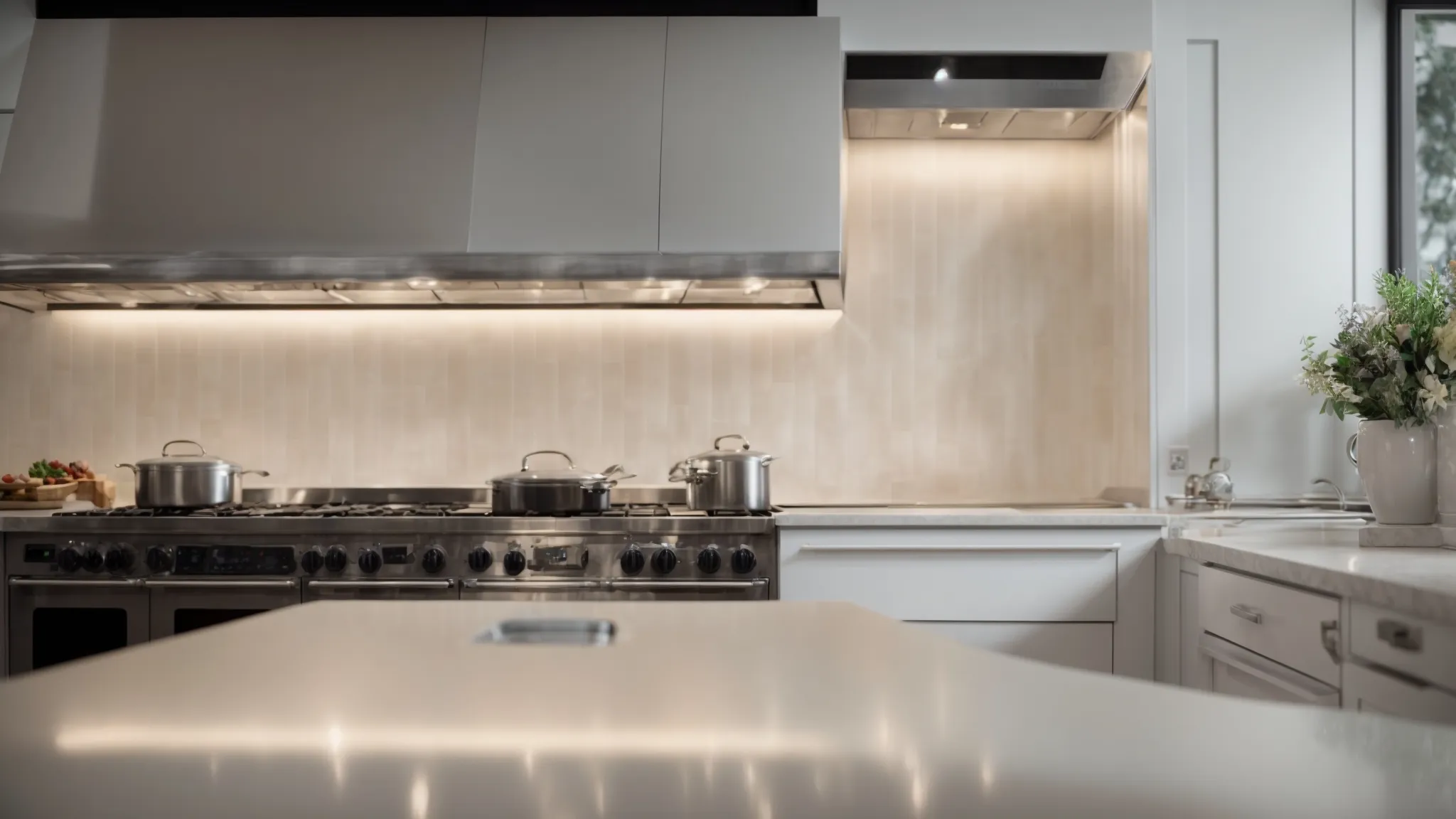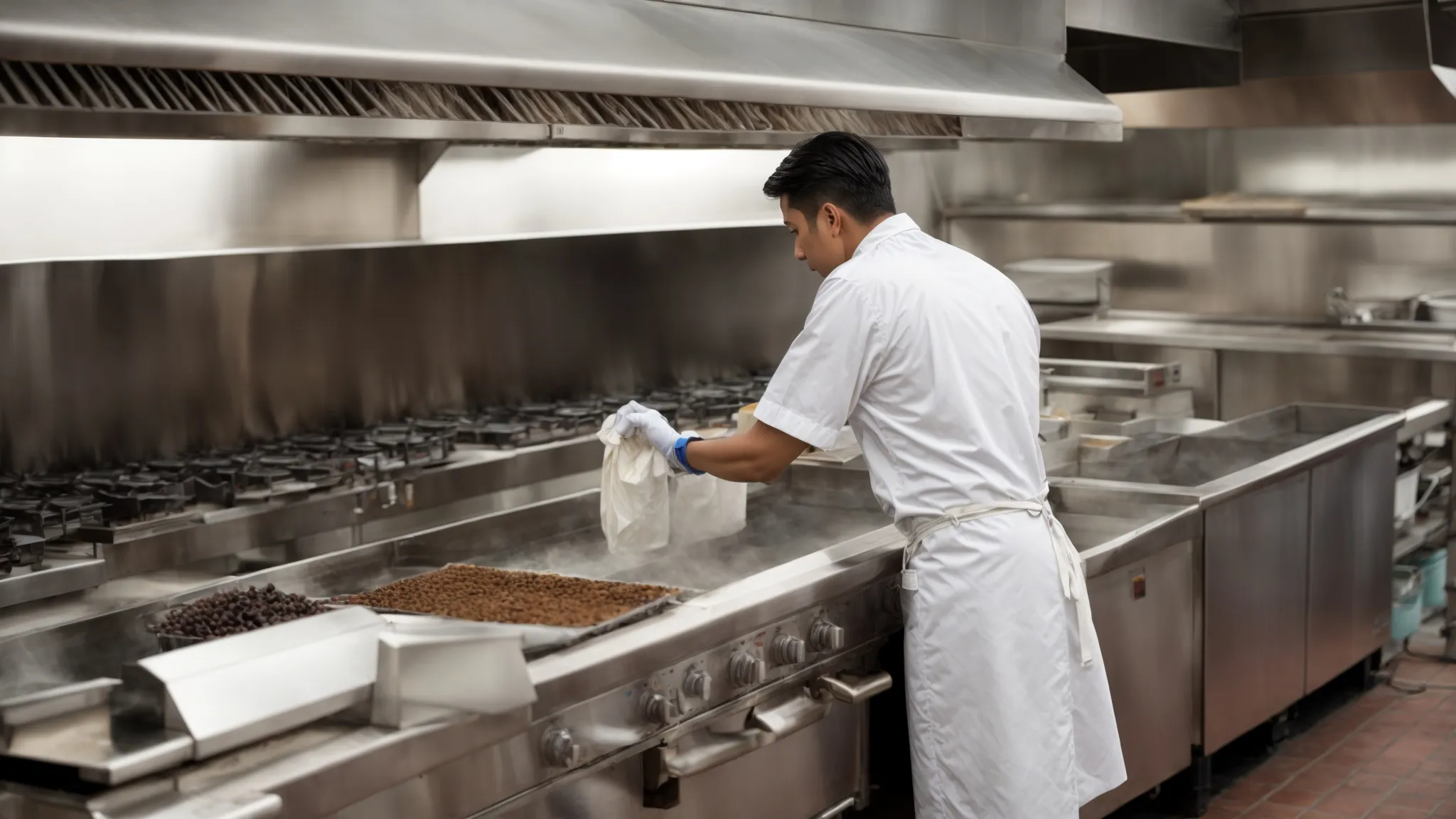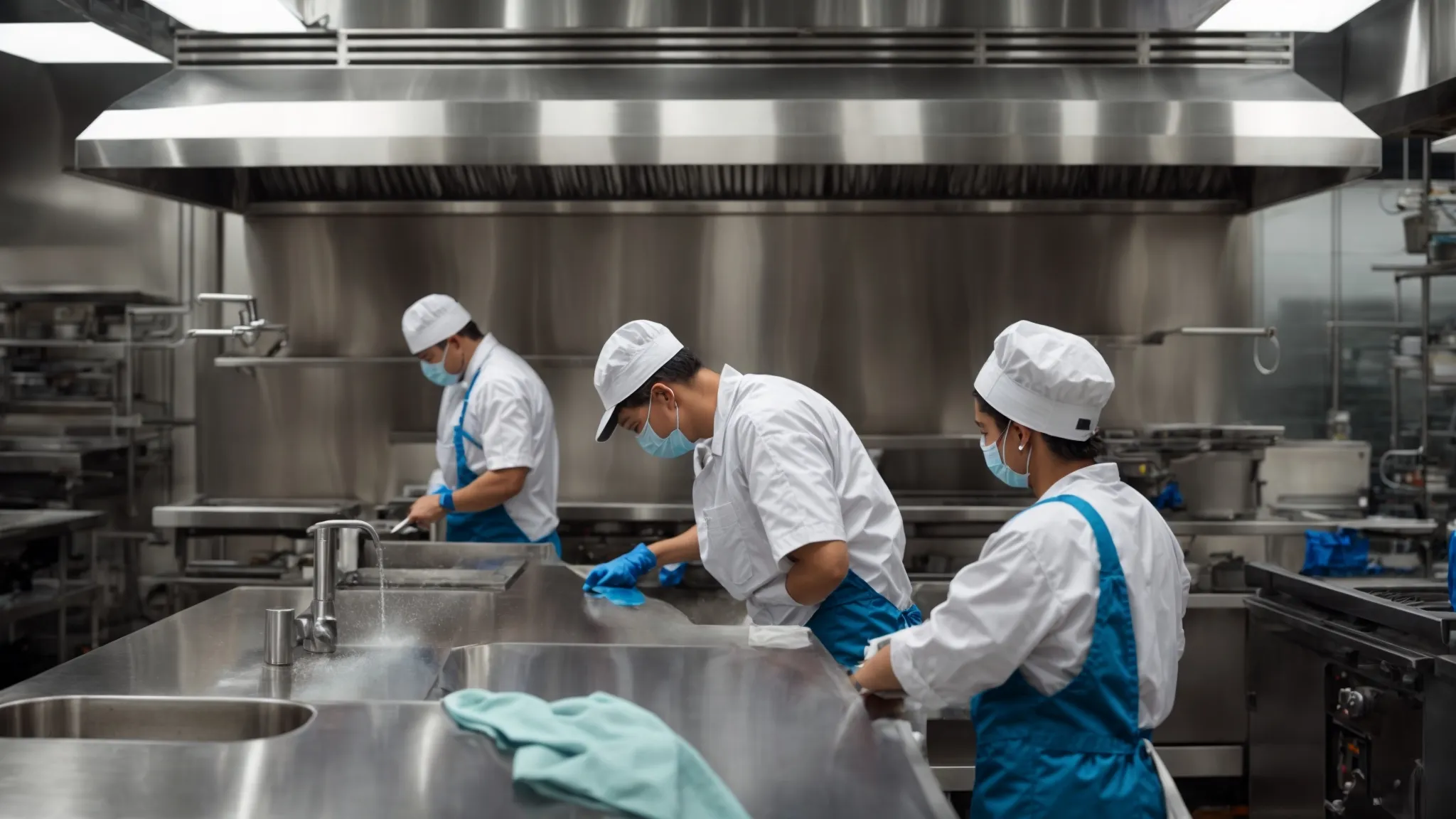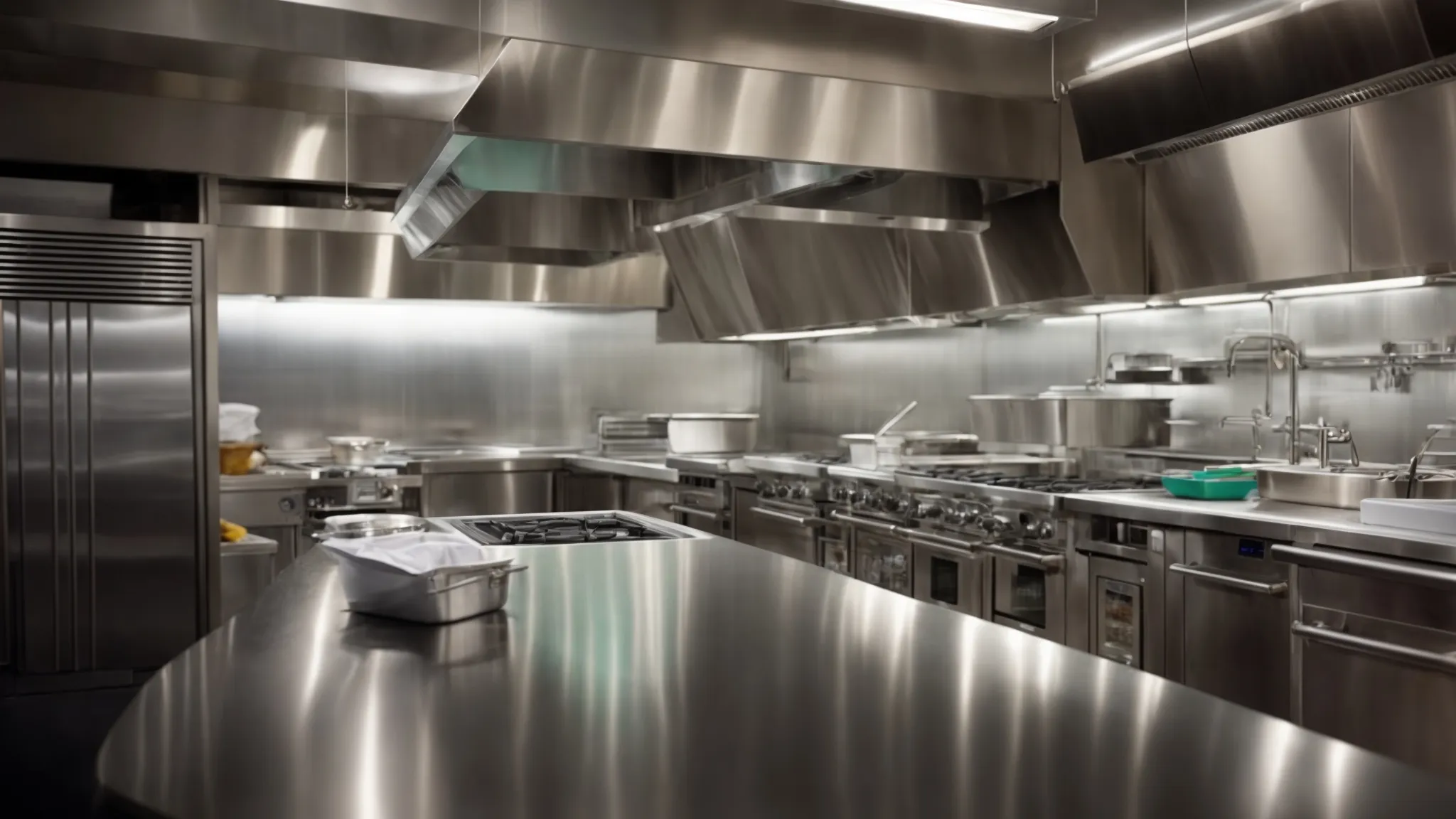The Essential Checklist for Kitchen Hood Cleaning Inspections
Understanding the Inspection Process for Commercial Kitchen Hood Cleaning
Navigating the labyrinth of kitchen hood cleanliness can feel akin to charting a course through uncharted waters, especially when the time comes for an all-important inspection.
This critical voyage not only ensures your commercial kitchen sails smoothly through health and safety regulations but also protects your crew and patrons from the invisible dangers of grease, dust, and contaminants lurking in exhaust systems.
From the deck of the stove hood to the depths of the grease trap, every component demands a meticulous eye to thwart fire hazards and maintain air quality.
In this article, we embark on a journey to chart the essential checklist for kitchen hood cleaning inspections, guiding you through the murky waters of compliance and cleanliness.
Key Takeaways
- Scheduling Kitchen Hood Cleaning Inspections During Downtime Minimizes Operational Disruption
- Proper Use of Cleaning Tools and Detergents Exceeds Regulatory Standards and Enhances the Cleaning Process
- Regular Maintenance and Staff Training in Hood Cleaning Techniques Prevent Accumulation Hazards
- Professional Cleaning Services Provide Comprehensive Care, Addressing Areas Beyond the Capabilities of Regular Staff
- Documenting the Inspection Process Ensures Compliance and Serves as a Defense Against Legal and Regulatory Challenges
Preparing for Your Kitchen Hood Cleaning Inspection

Embracing the rigorous voyage of kitchen Hood Cleaning inspections demands a meticulous blueprint for preparation, a testament to the adage that success resides in the details.
Foremost, orchestrating the inspection during a period of downtime becomes not just a suggestion, but an imperative strategy, ensuring that the rhythm of culinary artistry faces no interruption.
Correspondingly, amassing an arsenal of necessary cleaning tools and advanced detergents lays the groundwork for not only meeting the standards set by regulatory bodies but exceeding them.
As stewards of cleanliness and guardians against the invisible adversaries of grease and grime, this preliminary stage crafts the crucible within which safety and hygiene forge an unbreakable alliance, steering towards the ultimate goal of surpassing the kitchen hood cleaning inspection with unparalleled distinction.
Schedule the Inspection During Downtime
Choosing a moment when the kitchen’s flames dim, and its pots rest allows for a dance of brushes and solutions in solitude: this is the essence of scheduling your kitchen hood cleaning inspection during downtime. It ensures that the meticulous scrubbing and inspection process unfolds under the keen eye of tranquility, away from the bustling orchestra of daily kitchen operations.
| Stage | Activity | Benefit |
|---|---|---|
| Pre-Inspection | Identifying ideal downtime | Minimizes operational disruption |
| During Inspection | Conducting thorough cleaning | Facilitates detailed examination |
| Post-Inspection | Review and adjust operation hours if needed | Optimizes future scheduling |
Transforming this quiet period into an advantage, culinary establishments harness the benefit of attention to detail that can only arise from an uninterrupted focus. Each spray of degreaser and stroke of the brush becomes a step towards not just compliance, but excellence, in maintaining a kitchen free of contamination and hazards.
Gather Necessary Cleaning Tools and Detergents
Embarking on the path to a spotless kitchen demands arming oneself with the right tools of the trade. From sturdy brushes that whisper through the grease-laden air of exhaust hoods to potent detergents that tear through the toughest of grime, selecting the appropriate arsenal is akin to choosing the right key for a lock, ensuring that every corner of the kitchen hood surrenders its hidden filth.
The choice of detergents, a beacon of hope in the relentless fight against oil and bacteria, must be informed by their ability to dissolve the residues that cling onto surfaces with stubborn resolve. Coupling these powerful cleaning agents with high-quality equipment not only manifests a commitment to excellence but also elevates the cleaning process from mere duty to an art form, allowing the kitchen’s heart to beat uninhibited by the threat of contamination.
Now that you’re armed with the essentials for a spotless inspection, let’s turn our attention to the battleground itself. Delve into the hidden alcoves and every nook that whispers secrets of untold stories, identifying common areas of concern in hoods.
Identifying Common Areas of Concern in Hoods

The voyage toward immaculate kitchen hood maintenance charters through the terrain of meticulous inspection, where vigilance in recognizing common issues becomes the compass guiding safety and compliance.
Amidst the labyrinth of kitchen exhaust systems, two formidable foes emerge as frequent culprits of operational inefficiency: the stealthy accumulation of grease on seemingly innocuous surfaces and the silent blockade formed by dust and debris in the crevices of exhaust fans.
Confronting these adversaries head-on with a discerning eye not only upholds the bastion of cleanliness but also reinforces the fortifications against potential hazards that lurk within the kitchen’s bustling epicenter.
Check for Grease Accumulation on Surfaces
In the meticulous mission of ensuring kitchen safety and regulatory adherence, scrutinizing the restaurant hood and exhaust for grease accumulation emerges as a pivotal endeavor. This scrutiny unveils the imperceptible threats posed by grease: it’s not merely a surface issue but a profound safety peril, setting the stage for potential fire hazards.
| Area of Concern | Inspection Technique | Outcome |
|---|---|---|
| Grease Accumulation on Surfaces | Visual Inspection & Thickness Testing | Identification of Fire Hazards |
Diligently examining the nooks and crannies of the kitchen exhaust system, professionals employ both visual assessment and specialized tools to gauge the extent of grease build-up. This dual approach ensures no hidden grease deposit goes unchecked, bolstering the kitchen’s defenses against fire and contamination.
Inspect Exhaust Fans for Dust and Debris Blockage
Peering into the heart of a commercial kitchen’s ventilation system, the exhaust fans often harbor a silent foe: blockages caused by dust and debris. This insidious build-up not only impedes airflow but also escalates the risk of overheating, transforming these critical components into unwitting hazards.
- Survey the exhaust fans meticulously for any signs of dust accumulation.
- Remove debris that could obstruct the fan blades or housing.
- Assess the overall functionality of the exhaust system post-cleaning.
To counteract these hidden threats, a detailed inspection of exhaust fans for dust and debris blockage becomes a cornerstone of kitchen hood cleaning efficacy. Through proactive identification and removal of such blockages, restaurants ensure the longevity of their exhaust systems and safeguard the kitchen against potential fire risks and inefficiencies.
Peeling back the layers of hood maintenance unveils a hidden world, one vital to your kitchen’s heart and health. Let’s shift our focus, till the soil of understanding around the backbone of any commercial kitchen: its ventilation system’s efficiency.
Evaluating the Ventilation System’s Efficiency

In the labyrinth of culinary excellence, the heart beats strongest where air flows freely, underscoring the importance of evaluating the ventilation system’s efficiency in the sacred ritual of kitchen hood cleaning inspections.
True mitigation against the invisible foes of smoke and unwanted odors, this chapter of inspection delves deeply into ensuring that each breath of air circulated within the kitchen sails smoothly, unburdened by the weight of obstruction.
Testing airflow to ensure proper ventilation becomes a compass by which the health of the kitchen’s lungs is measured, while the vigilant assessment of filters, ready to be replaced if found wanting, acts as the guardian of purity in this complex respiratory system.
This scrutiny not only enshrines a commitment to safety and health standards but also elevates the kitchen’s operation to a harmony of efficiency and cleanliness.
Test Airflow to Ensure Proper Ventilation
Embarking on the examination of airflow within a commercial kitchen’s ventilation system embodies a critical juncture in ensuring a healthful and efficient environment: it challenges the very elements to reveal the truth about the kitchen’s pulmonary function. This step, vital in the sequence of a kitchen hood cleaning inspection, utilizes specialized equipment to measure the velocity and volume of air circulating through the ducts, ensuring that the breath of the kitchen is neither stifled nor wheezing under pressure.
- Deploying anemometers to gauge airflow speed and volume.
- Identifying any disruptions or deviations from optimal airflow levels.
- Recommending adjustments or repairs to rectify identified issues.
The process of testing airflow serves as the beacon that guides kitchen operations toward regulatory compliance and operational excellence. By highlighting discrepancies in the expected versus actual performance, it paves the way for remedial actions, ensuring that the kitchen’s ventilation system operates at its peak, unfettered by obstructions or inefficiencies.
Assess the Condition of Filters and Replace if Needed
In the quest for kitchen hood cleaning mastery, the examination of filters emerges as a pivotal chapter. These guardians against pollution and grease play a crucial role in maintaining the sanctity of a restaurant’s air quality. Thus, assessing their condition morphs into an act of vigilance, ensuring the kitchen breathes clean, uncontaminated air.
Should these crucial barriers show signs of wear or saturation, their swift replacement is non-negotiable. This decisive action not only fortifies the kitchen against the infiltration of grease and odors but also secures the efficiency of the ventilation system, ensuring it operates with the precision and effectiveness demanded by both chefs and regulations alike.
With a thorough understanding of your ventilation system’s efficiency, the adventure doesn’t end here. The stage is set to embark on a regimen of steadfast maintenance, ensuring your kitchen breathes with ease.
Implementing a Regular Maintenance Routine

The cornerstone of ensuring a seamless kitchen hood cleaning inspection transcends beyond the singular act of auditing; it fundamentally resides in the cultivation of a regular maintenance routine.
Tailoring a cleaning schedule that aligns with the unique demands of kitchen usage becomes imperative, preventing the accumulation of hazards that may lurk unseen.
Furthermore, empowering the culinary brigade with basic hood cleaning techniques equips them with the tools necessary for upholding standards of cleanliness and safety.
Together, these practices weave a fabric of prevention, ensuring that when the time for inspection arrives, success is not a hopeful ambition but an expected outcome.
Develop a Cleaning Schedule Based on Kitchen Usage
In the bustling world of culinary arts, the frequency of kitchen hood cleanings cannot adhere to a one-size-fits-all approach; it has to be meticulously calibrated to the distinctive rhythm of each kitchen’s operations. Establishing a bespoke cleaning schedule, attuned to the intensity of cooking and the types of food prepared, stands as a pivotal measure in upholding unyielding standards of cleanliness and safety.
By tracking the usage patterns of cooking equipment and correlating them with the accumulation rate of grease and debris, commercial kitchens can craft a maintenance rhythm that harmonizes with their unique culinary tempo. This proactive stance ensures that the vital conduits of ventilation remain clear, embodying both a commitment to excellence and a bulwark against the specters of contamination and fire risk.
Train Staff on Basic Hood Cleaning Techniques
Equipping staff with basic hood cleaning techniques is not merely about maintaining a spotless kitchen; it’s about embedding a culture of safety and diligence within the heart of a culinary establishment. This foundational knowledge enables every member of the team to recognize the early signs of grease buildup and understand the proper use of cleaning agents and tools.
Integrating this training into the routine practices ensures that the battle against grime and potential hazards is a collective effort. Staff members become vigilant sentinels, armed with the expertise to address minor issues before they escalate into significant threats:
- Identification of grease accumulation points.
- Proper application of degreasers and detergents.
- Safe handling and maintenance of cleaning equipment.
Embracing a diligent maintenance routine is the first step; yet, the journey doesn’t end there. When the stakes are high and precision is non-negotiable, calling in the experts becomes your secret weapon.
Utilizing Professional Services When Necessary

At the juncture where diligence meets complexity in the endeavor to maintain kitchen hoods, there comes a critical moment to discern when the intervention of professional cleaning services transcends from option to necessity.
Encounters with overwhelming grease accumulation or the intricate specifications of advanced exhaust systems, for example, herald this pivotal decision point.
This necessitates not only the identification of the opportune moment to engage professional cleaners but also a comprehensive understanding of the suite of services that should accompany such professional intervention.
The elucidation of these aspects ensures that commercial kitchens not only adhere to the highest standards of cleanliness and safety but also leverage expert proficiency to navigate the nuanced terrains of hood and exhaust maintenance.
Identify When to Call in Professional Cleaners
Recognizing the threshold at which professional cleaners become an imperative rather than an option marks a crucial point in kitchen maintenance strategy. Faced with either the labyrinthine complexity of advanced ventilation systems or the daunting task of addressing thick, pervasive grease layers, the time to enlist expert services is clear. This decisive action ensures adherence to stringent safety and cleanliness standards, safeguarding both staff and patrons alike.
Engagement with professional cleaners becomes paramount when kitchens navigate the challenges of extensive use or specific cleaning needs that surpass ordinary capabilities. Whether it is the sheer scale of the operation, the specialized nature of the equipment, or regulatory mandates demanding certified expertise, turning to seasoned professionals ensures that kitchen hood cleaning is executed with precision, efficiency, and an unwavering commitment to excellence.
Review What Services Should Be Included in Professional Cleaning
A thorough professional cleaning service delves beyond the superficial, targeting not only the kitchen hood itself but also the intricate web of ducts, fans, filters, and exhaust systems. These teams employ advanced techniques such as steam cleaning, pressure washing, and chemical degreasing to ensure every inch of the kitchen’s ventilation system operates at its peak, free of grease, debris, and contaminants that could compromise safety and efficiency.
In addition to the physical cleaning, a comprehensive service offering should encompass a detailed inspection process, identifying any potential risks or hazards, from structural deficiencies to non-compliance issues with fire codes and health standards. This holistic approach guarantees not only the physical cleanliness of the kitchen’s ventilation system but also its adherence to the stringent regulations that govern commercial kitchen operations, ensuring ongoing safety and operational excellence.
Bridging the gap between expertise and oversight, we embark on a journey to transparency. Let’s illuminate the path to documentation, where compliance meets clarity in every step.
Documenting Your Inspection Process for Compliance

Documenting the kitchen hood cleaning inspection process stands as a crucial step in ensuring adherence to compliance standards. It serves not only as a record of diligence and safety but also as a safeguard against potential legal and regulatory scrutiny. By meticulously capturing every action and outcome, restaurants affirm their commitment to maintaining a clean and safe cooking environment.
From the onset of the inspection, every observation, procedure, and corrective action taken should be recorded with precision. This practice not only chronicles the journey towards regulatory compliance but also creates a transparent trail that can be reviewed, analyzed, and acted upon in future inspections. It’s the bridge between performing the procedures and proving their execution to any governing body or insurance entity.
Incorporating photographic evidence into the documentation process enhances its integrity, offering visual substantiation of the cleaning and maintenance activities carried out. These images, paired with detailed notes, craft a compelling narrative of the kitchen’s upkeep, showcasing efforts to mitigate risks associated with grease, debris, and other contaminants. This combination of textual and visual documentation enriches the inspection file, making it a robust tool for compliance and safety assurance.
Lastly, the assembly of all documentation into a comprehensive report not only completes the inspection process but also arms the establishment with a powerful instrument for ongoing compliance. This report, often required by health inspectors, insurance companies, and fire safety officials, is a testament to the establishment’s unwavering dedication to upholding the highest standards of kitchen cleanliness and safety. It symbolizes the final step in the meticulous endeavor of kitchen hood cleaning inspections, underlining the importance of detail and precision in achieving and surpassing industry benchmarks.

